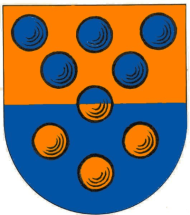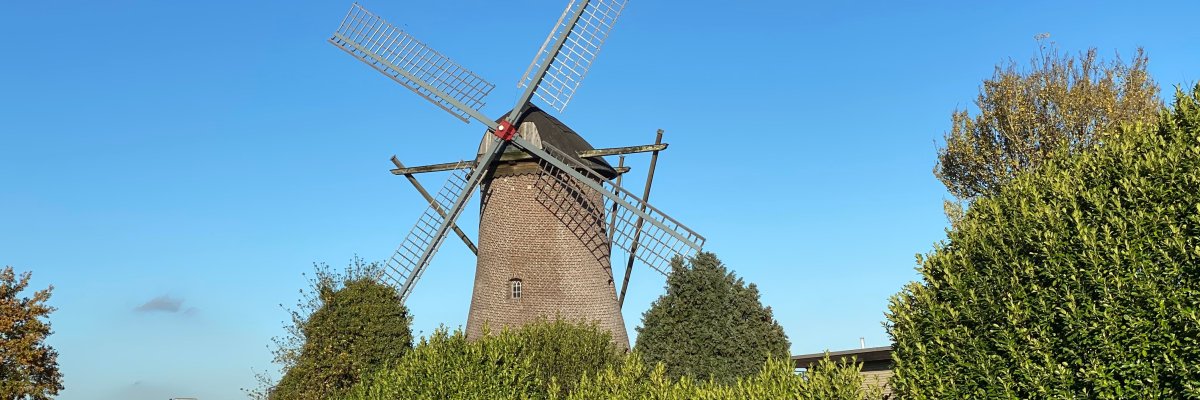Twisteden
Twisteden is home to 2,568 inhabitants (as of 31.12.2023) on an area of 1,340 ha. The popular farm oasis "Irrland" is located on the outskirts of Twisteden. Irrland is a large family and adventure park that is particularly popular with children and young people, even beyond the borders of Kevelaer. Originally founded in 1999 as a sideline of a farm with a corn maze, the park has expanded over the following years to cover an area of 300,000 m² with many attractions. Twisteden was awarded a gold medal in the 1998 national competition "Our village has a future".
Coat of arms

"Twisteden" actually means "two places" - referring to the two historical settlements of Heuvens and Huxen, from which the present-day village was once formed. From a heraldic point of view, this division into two parts finds its very simple symbolic expression in the mixed up two colors of the coat of arms: nine balls are arranged blue on yellow in the upper field of the coat of arms and yellow on blue in the lower field. The nine balls are the signs of St. Quirinus, the patron saint of Twisteden. Experts have already argued about how the saint came to have these symbols. The current theory is that around 1500, Twisteden belonged to a monastery in Neuss. The Roman tribune and saint Quirinus was venerated there. Carved in stone, he looks down from the town hall there and shows the mysterious nine dots on his lance flag. Twisteden was granted parish rights by this Neuss monastery in 1571, and Quirinus has been the patron saint of the municipality ever since. The town of Neuss is of Roman origin and was called Novesia at the time. And this name gave St. Quirinus his bullets: the Latin word for nine is novem and the first four letters are the same as in the city name Novesia.
History
The megalithic graves found in Twisteden indicate a long history of settlement. The oldest surviving source in which the farming community of Twisteden is mentioned dates back to the late Middle Ages. The Landmeisterrechnung of the Duchy of Geldern from 1342/43, a record of income and expenditure, states that the then Duke Reinald II stayed briefly in Twisteden. In 1342, on the Saturday after Carnival, he stopped off in Twisteden with his cavalcade to have lunch in his carriage. He then gave a total of 12 shillings to poor people with whom he had stabled his horses in gratitude for their hospitality. A drainage ditch "Heerenvoere", today known as the "Spanische Ley" or "Veensche Ley", formed the border between Walbeck and Twisteden even before 1342. Before the French period, the ditch was also the border between the duchies of Geldern and Kleve. According to the records of the surveyor Buyx, there must have been a place of justice with a gallows on this very ditch in the area of the "Wember Dyk", which is also the subject of several legends.
The parish church of St. Quirinus was built in the middle of the village of Twisteden, on Gerberweg, in 1471; a small chapel must have existed there previously. Until the last third of the 16th century, the parish of Twisteden and Kleinkevelaer belonged to the mother parish of Walbeck. In 1667, the church now had 209 people receiving Holy Communion. The "old church" was doubled in size in the first third of the 18th century. In the late summer of 1763, nine of the 52 farms in Twisteden burned down, presumably due to spontaneous combustion.
In the 19th century, the demand for coal grew steadily and large-scale mining began in the Ruhr region. At the turn of the century, so-called exploratory drillings or exploratory boreholes were also made in Twisteden, which even struck hard coal. However, the project was not carried out because the cost of mining the coal was too high. On the other hand, the mining and smelting of turf iron ore in the quarries around Twisteden continued from the Iron Age until the 19th century. The wooden trestle windmill erected at the beginning of the 19th century burned down in 1860 and was replaced by a massive stone windmill, the "van den Braaksche Windmühle". In the second decade of the 20th century, a new church was built on the Dorfstraße for the now rapidly growing community of Twisteden - according to a 1919 census, 115 houses were inhabited - and was consecrated in 1925. The previous church now serves as a cemetery chapel.
The municipality of Twisteden (Amt Kevelaer), which had been independent since the founding of the district of Geldern (1816), was incorporated into the town of Kevelaer in 1969. Twisteden won the federal gold plaque in the national competition "Our village should become more beautiful", now renamed "Our village has a future", in 1998.

